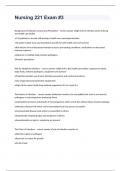Exam (elaborations)
Nursing 221 Exam #3 Herzing University - Question and answers already passed
- Course
- NSG 221
- Institution
- Herzing University
Nursing 221 Exam #3 Herzing University - Question and answers already passed Nursing 221 Exam #3 Background of Infection Control and Prevention: - correct answer oHigh risk for infection when entering any health care facility o1:25 patients in any day will develop a health care associated inf...
[Show more]



